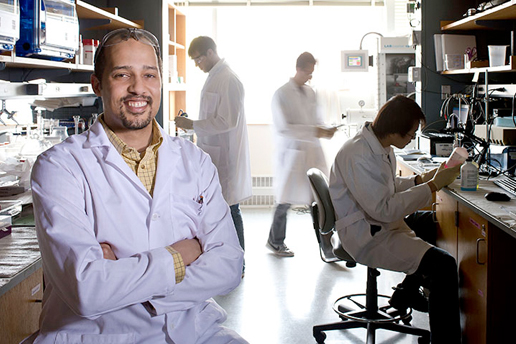
Fikile Brushett is in the process of taking the power generated by wind and solar, chemically lashing it to molecules derived from flora and fauna and storing it in liquids until it’s needed to electrify our homes.
The fact that such a system—if it’s even feasible—is likely years from reality doesn’t deter Brushett, who holds the Raymond A. & Helen E. St. Laurent Career Development Chair in chemical engineering. Brushett, an electrochemical engineer, works on applying fundamental electrochemistry to boost the performance and durability of our future energy storage systems.
A key 21st century challenge, Brushett says, will be storing and distributing energy in an efficient, sustainable fashion. “Converting energy from one form to another allows us to change the way we think about different energy-storage processes,” he said. A robust, cost-effective storage system, he says, is essential to make the intermittent electricity generated by wind and sun available 24/7, and might help boost the 4 percent of overall power now generated by these renewable sources in the U.S. to 25 percent or higher.
Our laptops and cell phones contain batteries with solid electrodes; Brushett and colleagues hope to transform energy storage with liquid electrode redox flow batteries. NASA introduced a version of these in the 1970s but they never took off, partly because of their reliance on pricey electroactive metal salts.
Unlike conventional rechargeable batteries, redox flow batteries store energy in solutions of electroactive compounds, which are housed in external tanks and pumped to an electricity-generating reactor. This system offers advantages in scalability, manufacturing, service life, and safety.
The chemicals can be stored in a tank as big as a water heater for home use, or as massive as a big-box store for powering an entire community.
Brushett, who says he’d “always been fascinated by engineering” and was drawn to energy research because of its societal relevance, envisions replacing redox flow batteries’ expensive metal salts with engineered versions of organic electroactive materials derived from biomass, such as quinones—naturally abundant compounds that play important roles in photosynthesis, respiration, and even the defense mechanisms of bombardier beetles.
“Organic molecules can, in principle, help us take that extra jump to make cheaper, more energy-dense flow batteries that are more economically viable,” he says.
Brushett’s is one of few research groups in this emerging field, which takes the “different, riskier approach of re-purposing and engineering natural molecules not designed to do the kind of energy storage we’d like them to do,” he says. “We don’t understand a whole lot about how to store energy in these molecules, how to make them practically applicable. No one knows how to do that just yet,” but the potential payoff is huge: high-powered fuel cells, next-generation rechargeable batteries, and amped-up photovoltaics, all from carbon-friendly, renewable sources.
“The bottom line is, the lights have to come on when we flip a switch, but we have to think about where those electrons are coming from,” Brushett says. “This approach could be much more efficient and a lot greener than the processes we use today.”